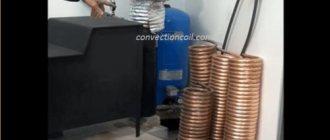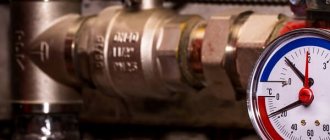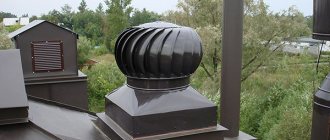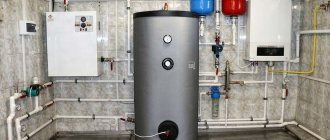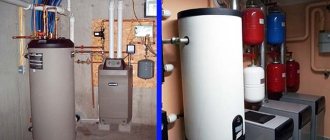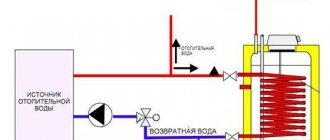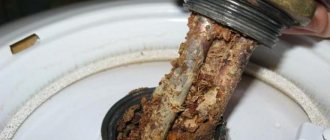How does an electric water heater for heating work?
In accordance with the power indicator, flow heaters are powered from a single or three-phase electrical network. The unit has a simple design and is a tank with heating elements installed inside. When liquid enters, they heat it to a predetermined temperature. When using the unit, a heat exchanger is installed in the heating system.
Electric water heater device.
To obtain hot water for domestic purposes, the coolant is supplied through a special connecting tube to the faucets in the bathroom and kitchen. At the same time, the warm air mixture enters the living quarters. Before installing a heating unit in a private house, perform the following steps in sequence:
- Organize the circulation of coolant in the heating system.
- Create a sealed circuit.
- An expansion tank, an electric pump and shut-off valves are installed.
- Provide the ability to regularly supply liquid from a centralized water supply.
With constant fluid renewal, the heating rate is low. You can get detailed advice on the technical characteristics and operating rules of such units in the Kvanta+ online store in Tyumen.
Installation and operation of a heating boiler
Boiler in the heating system
After performing all the necessary calculations of the boiler power and its volume, you can begin to integrate the device into the heating system. An important task is to determine the installation location. Having decided on the purpose of the boiler in the heating system, you need to read the instructions for its installation. The best option would be to install it in close proximity to the boiler. In this case, the transfer of thermal energy from the coolant to water is most effective.
But at the same time, you may encounter the following difficulties in organizing heating using a boiler:
- DHW system supply . In a heating system with a solid fuel boiler, it is most convenient to place the boiler directly in the boiler room. But then to supply heated water to the premises you will need a separate pump and control devices for it;
- A large volume of capacity if heating through a boiler is planned for large residential areas. There is a problem with the placement of the heating element;
- Electrical supply to ensure the operation of the heating element . For the normal functioning of the boiler for heating a private house, it is also recommended to install an autonomous source of electricity.
Having resolved these issues, you can proceed directly to installation.
The heating water temperature through the boiler is controlled using an installed thermometer. It is not included in the standard package and therefore must be purchased separately.
Installation of a heating storage tank
Installed boiler
To install the heat accumulator, it is necessary to prepare a flat area in advance. Its heavy weight should be taken into account - if necessary, a separate foundation is made or the floors are reinforced.
The optimal installation option is on a separate platform. This way you can avoid contact of the housing with the concrete surface, which will reduce heat losses in the electric heating boiler. Almost all manufacturers make containers with special legs. If they are missing, it is recommended to install insulation on the floor.
The procedure for connecting the boiler to the heating system is to perform the following steps:
- After installing the container, you need to check its position relative to the horizon. No deviations are allowed.
- Connect to the heating. It is important that the diameter of the pipes is equal. Otherwise, after connecting the boiler to the heating system, excess hydraulic resistance will appear.
- If installation is carried out in an unheated room, the boiler body is insulated.
- A connection to the hot water supply is made so that the boiler works not only for heating, but also for hot water supply.
Upon completion of this work, you need to check the tightness of all connections and start the heating system. It is recommended to measure the temperature of the water in the tank and the coolant in the pipes within 2-3 weeks after the boiler is turned off. This way you can determine the actual time of maintaining the required heating level in the heating circuit from the boiler.
In order to make full heating from a boiler, it is not recommended to use antifreeze. It is characterized by a relatively low heat capacity, which will affect the transfer of heat to water and back to the coolant.
Conditions for proper operation of the boiler
Scale on the heating element of the boiler
Servicing the storage tank is practically no different from carrying out the necessary procedures to maintain the functionality of any electric boiler with heating elements. And in this case, in order for the boiler to work normally in the heating system of a private home, you must follow the manufacturer’s recommendations.
This can be ensured even before the heat supply from the boiler is made. It is best to purchase models with the so-called “dry heating element”. On it, scale formation occurs much more slowly. You should also pre-filter the water before feeding it into the storage tank.
In addition to these procedures, you must do the following:
- Once a month, check the integrity of the thermal insulation of the structure;
- Monitor the duration of maintaining the coolant temperature during the heat supply mode through the boiler. The difference between calculated and actual indicators should not exceed 15%;
- Checking the tightness of connections. It is recommended to replace the gaskets before each heating season. This way you can achieve more reliable heating of a private home using a boiler.
The control unit of some models is sensitive to voltage changes. To avoid damage to this expensive device, you should connect a stabilizer for the boiler in the heating system.
To clean the heating element from scale, you must dismantle it. But before that, you need to find out from the seller whether the factory warranty is still valid.
Electric boiler or water heater
In heating systems, boiler boilers are more often used, designed specifically for this purpose. In terms of the ratio of the amount of thermal energy received to the resources spent, storage boilers are significantly more efficient than instantaneous water heaters. The efficiency of the first reaches 90%, and that of the second does not exceed 70%. This is due to:
- design;
- specificity of purpose;
- method of heating the coolant.
Models of water heaters.
Instantaneous water heaters are designed for use in closed systems with forced circulation of liquid. The units have the following advantages over storage electric boilers:
- Fast water heating.
- No restrictions on the volume of hot liquid.
- Simplicity of design.
- Ease of use.
- Ease of installation.
- No need for regular maintenance.
In addition, you can make heating from a water heater with your own hands. Among the disadvantages of flow-through units are:
- the need for careful monitoring of the functional state and performance of the device;
- relatively high cost;
- low energy efficiency.
Electric boilers provide constant access to hot water within the volume provided by the design.
Method of heating water with a water heater
In terms of the method of increasing the temperature of the energy carrier, a flow device does not differ from a storage boiler. The sealed tank is filled with liquid from a centralized water supply. Electric heating elements increase the temperature to a given level. Units of 2 types are characterized by some loss of thermal energy.
Diagram of water heating by the device.
In a storage boiler, the temperature of the liquid rises inside a sealed container with an integrated heater. Since the volume of the chamber is small, the process proceeds rapidly and with little heat loss. The design of such units includes:
- Electric pump.
- Storage tank.
- Mechanism for controlling water supply and heating temperature.
Flow units lack the first 2 components.
Calculation of the volume of the storage tank and the power of the heating element
At the first stage, it is necessary to calculate the power of the boiler for heating the house. There are several ways to solve this problem. The best way is to read the recommendations from the manufacturer of a specific tank model.
It must be taken into account that the heating scheme from the boiler directly depends on the power of the entire system. Therefore, this value is taken as the initial parameter. Let's assume it is 1 kW/h. After installing a boiler in the heating system of a private home, it must maintain the optimal level of water heating for another 5 hours. In this case, the thermal mode of the system is 75/50 (low temperature). In this case, the optimal volume of the boiler for heating and hot water supply is calculated using the following formula:
V=5/(75-50)=0.5 m³ or 500 l
The resulting volume can be reduced if you purchase a boiler model for heating a summer house with a heating element. Then, when calculating, you need to take into account the specific power of this device. On average, to ensure full heating operation when the boiler is turned off and the average DHW consumption rate (10 l/hour), you need to purchase a model with a volume of about 400-450 liters.
To fully calculate the power of a boiler for heating a house, it is necessary to take into account all factors - heat losses in the building, location of the tank in the system, etc.
Heating inertia
Boilers are characterized by the rapidity of temperature rise in the pipes of the heating system. In 15-20 minutes the water heats up to 60°C. In this aspect, flow devices are inferior to traditional boilers. Heating water in a storage tank with a capacity of 150 liters takes 40-50 minutes. The rate of temperature increase is affected by the performance of heating elements. After turning off the electric boiler, the water in the heating pipes quickly cools down.
Instantaneous water heaters require several recirculation cycles to lower the liquid temperature to room temperature. In the event of an unexpected power outage, the water remains hot for some time. Necessary conditions for the use of flow-through units in heating objects such as a private house:
- A small heating area, which is dictated by the ratio of 1 kW of consumed electricity to 10 m² of area.
- High quality coolant for durability and normal functional condition of the working elements of the unit.
- To circulate the liquid, you need a pressure similar to a centralized water supply system - 4 atm. In models equipped with a circulation pump, 1.5 atm is sufficient.
Appearance of instantaneous water heater.
Instantaneous water heaters are used to heat a small cottage with an area of up to 80 m². This applies to outbuildings and country houses. Another area of application for such heating equipment is the installation of heated floors.
Types of devices
When choosing a boiler for heating, many are interested in its two parameters. The first is the volume of the tank, the second is the electrical energy consumed.
Instantaneous water heater
A flow-through water heating boiler does not have a container designed for a large volume. It is designed so that the water consumed is heated instantly. There are two types used in everyday life:
- Electric - production takes place in a compact case, wall mounting. Water is heated as it passes through an electric heater.
- Gas - water flows inside the heat exchanger. A gas burner burns under it, which heats the liquid.
We recommend: Coaxial pipe for a gas boiler: types, features and installation diagrams
An instantaneous electric water heater intended for heating has the following device:
- Body - the material is metal or plastic, the outside is covered with a special coating for protection and decoration.
- Heat transfer tube - located inside the housing, most often has a spiral shape.
- The heating part is located in the heat exchange tube or in a separate metal glass.
- Flow meter - there is a reaction to the closing/opening of the faucet mixer.
- Electromagnetic starter - controls a magnetic starter and is a powerful electric heater.
- Thermostat - turns the unit on/off, regulates the supply of hot water based on the pressure power.
- Thermal fuse - necessary for emergency shutdown of the device.
| pros | Minuses |
| Light weight, compact parameters | Due to their complex manufacturing, their price is quite high. |
| It is possible to operate immediately as soon as it is turned on, since the water heats up quickly | High electricity consumption |
| Connection and installation can be done independently in an hour and a half | To connect, it becomes necessary to lay another network cable separately |
| All parts inside are made of metal that is not subject to corrosion |
Electric storage boiler
Electric storage boilers are most often used in everyday life. Externally they have differences, but the device itself is the same:
- The case is made of steel with a thickness of 0.8 millimeters. A polyester enamel coating is applied on top, serving not only as decoration, but also as protection.
- The tank is located inside the body, made of steel 1.2 millimeters thick, the outside is coated with corrosion protection. It has three types. The first is a heat-strengthened coating, used in inexpensive models. It is considered not particularly durable: the enamel can crack and crumble due to a sharp change in temperature. The second is glass ceramics, applied at high temperatures, very durable. The third is titanium coating, the most durable and strong, used on expensive models.
- Thermal insulation - minimum thickness is 20 millimeters, maximum - 40. It looks like a layer between the tank and the outer casing.
- Magnesium anode - designed to protect against rust. Installation takes place near the heating element and protects the tank and heating part from electromechanical corrosion.
- Heating element - located at the bottom of the tank.
- Thermometer - digital or mechanical. Located outside the housing, designed to control water.
- Thermostat - automatically turns on/off the heating element. Adjustment is manual or electronic.
- Indicator LED - connected to the thermostat, lets you know when the heating element is on or off.
- Water pipes are made of metal, end with a thread on the outside, and are connected to the water supply.
- Mounting Bracket - Used to mount the unit to the wall.
| pros | Minuses |
| A large assortment | Installation should only be carried out on a solid wall due to the heavy weight of the devices |
| Installation is simple, easy, completed in a couple of hours | Maximum service life is nine years, as corrosion resistance is reduced |
| Part replacement takes a maximum of one and a half hours | Due to the insulation, the parameters are quite dimensional |
| Low electricity consumption | Takes a long time to heat up (from half an hour to nine hours) |
| A thick layer of scale appears |
Indirect heating boiler
This unit is a sealed tank with a built-in electric coil. The water in it is heated by circulating liquid in a closed circuit and coming into contact with the heating element. Electric operation allows you to constantly have a supply of warm water, and an intelligent control system ensures comfortable operation of the device. Such equipment is made of stainless steel with a heat-insulating glass-ceramic coating.
A sealed container with a volume of up to 1000 liters can provide hot water to a large mansion. Depending on the design and type, the indirect boiler is connected to the gas supply system or to the electrical network. Such equipment is equipped with an automated control mechanism. In winter, the unit can be used for heating and hot water supply, and in summer only for heating liquids.
Indirect water heater device.
Such devices are characterized by high performance, efficiency and good ergonomics. Indirect boilers are either wall-mounted or floor-mounted. The unit takes some time to initially heat the water. Subsequently, the set temperature is maintained automatically. Heat loss is minimal thanks to reliable thermal insulation. Similar heating equipment can be purchased in the Kvanta+ online store in Tyumen.
Instantaneous water heater
A good solution for small residential and technical facilities is an instantaneous water heater. The average productivity of a 2 kW unit is 12 l/min up to a temperature of 60°C. This device is suitable for both private cottages and country houses with non-permanent residence. It is used to provide hot water and space heating. Advantages of instantaneous water heater:
- compact dimensions allowing you to place the equipment in any free space;
- low heating inertia value;
- the ability to adjust the temperature;
- integrated system for automatic shutdown of heating elements in the absence of coolant;
- a variety of models varying in power and price.
The only drawback of such a unit is its low efficiency, which is associated with high energy costs.
Selection of coolant for water heater and installation
The main technical parameter of the unit is the rate of heating of the coolant to a given temperature. When choosing a suitable model, you cannot be guided solely by the rated power indicated in the accompanying technical documentation. The expected operating conditions and heated area should be taken into account. The unit should be installed in a warm room to minimize energy losses. The electrical wiring must be able to withstand the maximum load generated by the water heater. Such data is indicated in the technical data sheet of the equipment.
Distilled water is considered the best filler. It has optimal heat capacity. For use in hot water supply and space heating systems, it is better to purchase a unit with closed heating elements. This design avoids scale formation. It is important to choose a device of the required power that is capable of coping with the functional tasks assigned to it.
Classification
Electric boilers are divided into three main types:
- heating elements;
- electrode;
- induction
In addition, there are a number of other differences between them. For example, there are floor or wall models. They can be connected to 380V or 220V - depending on the size of the room (used for a private house or small apartment). Also the main indicator is the number of circuits in which hot water is located - one or two.
heating elements new
An electric boiler operates based on the process of converting current into thermal energy through the use of tubular heaters installed directly in the tank. The heating element raises the temperature of the liquid inside the pipe. When it enters the heating system, it warms up the room.
To ensure that the device always works as required, a control unit is provided. The heating is controlled by a room temperature controller. It is he who perceives a decrease in this indicator and reports the need to increase heating. The required pressure appears as a result of connecting the pump. Thanks to the use of modern technologies, after the room temperature rises to the set point, the mode is turned off. After some time, the pump that moves the coolant also stops working.
The main advantage of this type of boiler is the absence of contact between the liquid and the heat exchanger. This allows the use of protective devices for automatic shutdown.
The equipment makes it possible to simply implement smooth or step control.
Like any other devices, these have their drawbacks. Heating element boilers have a limited service life compared to other boilers. Premature burnout due to improper use cannot be ruled out. Before purchasing, be sure to pay attention to the possibility of repair or replacement.
Also, scale quickly forms on the tubular heater itself. This significantly reduces the service life of the device. It is imperative to artificially reduce the hardness of the liquid.
Such water heating boilers are single- and double-circuit units. The latter provide hot water supply and heating.
In most cases, installations are hung on the wall, although there are also those that are located on a flat, hard surface.
This type is considered the most popular among electric boilers.
Electrode
Heating of the coolant is carried out by direct passage of current through it. In this case, there are no “intermediaries” in the form of heating elements. Electrolysis does not occur since the anode and cathode are constantly changing places.
It is important to note that if operated without liquid, the electric heating or hot water boiler will not fail. In addition, scale does not destroy the electrodes - sometimes a slight decrease in power is observed.
The coolant temperature increases quickly. This increases the pressure with which water moves through the network - there is no need to install a pump. Perfect for the bathroom as it doesn't take up much space.
We recommend: Installing heated electric floors
Such a water unit has an efficiency of about 96%. At the same time, it is durable and reliable in use.
Such a device cannot be connected through a protection element. Only special antifreeze is used as a coolant.
Induction
Such installations have a design similar to a transformer consisting of two circuits. The primary is the magnetic system, and the secondary is the heat exchange device. By means of an alternating field, electricity allows the coolant to be heated.
The main advantages include safety, as well as interaction with various heating fluids. Like the previous option, it is well suited for the bathroom.
But there are also disadvantages. The main ones are the initial price, as well as the cost of subsequent operation.
Boilers
It is worth mentioning electrical storage installations. In fact, they are heating elements equipment installed in parallel. In this case, they can be intended either separately for hot water supply or heating, or for both directions. For the latter, indirect heating systems are used. Such storage electrical installations make it possible to raise the temperature of water for household needs with coolant intended for heating.
This boiler is ideal for use in country houses. It is mainly installed together with boilers that use any energy source. At the same time, it is barely warm on the outside, since usually such installations have high-quality protection that allows energy to be stored inside for a long time.

